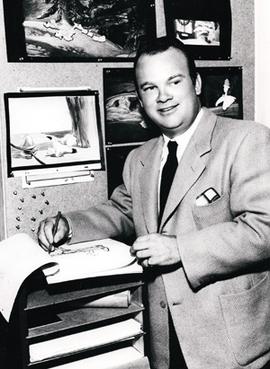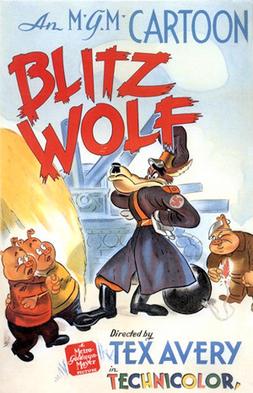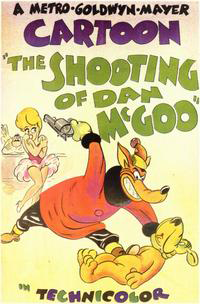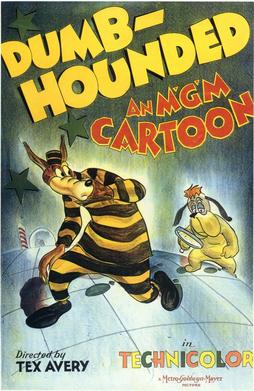
Frederick Bean "Tex" Avery was an American animator, cartoonist, director, and voice actor. He was known for directing and producing animated cartoons during the golden age of American animation. His most significant work was for the Warner Bros. and Metro-Goldwyn-Mayer studios, where he was crucial in the creation and evolution of famous animated characters such as Bugs Bunny, Daffy Duck, Porky Pig, Elmer Fudd, Droopy, Screwy Squirrel, The Wolf, Red Hot Riding Hood, and George and Junior.

The Big Bad Wolf is a fictional wolf appearing in several cautionary tales, including some of Grimms' Fairy Tales. Versions of this character have appeared in numerous works, and it has become a generic archetype of a menacing predatory antagonist.

"Little Red Riding Hood" is a European fairy tale about a young girl and a sly wolf. Its origins can be traced back to several pre-17th-century European folk tales. The two best known versions were written by Charles Perrault and the Brothers Grimm.

Droopy is an animated character from the golden age of American animation. He is an anthropomorphic white Basset Hound with a droopy face; hence his name. He was created in 1943 by Tex Avery for theatrical cartoon shorts produced by the Metro-Goldwyn-Mayer cartoon studio. Essentially the polar opposite of Avery's other MGM character, the loud and wacky Screwy Squirrel, Droopy moves slowly and lethargically, speaks in a jowly monotone voice, and—though hardly an imposing character—is shrewd enough to outwit his enemies. When finally roused to anger, often by a bad guy laughing heartily at him, Droopy is capable of beating adversaries many times his size with a comical thrashing.

Red, also known as Miss Vavoom in the 1990s, is an American animated character, created by Tex Avery, who appears in several MGM short films and Tom and Jerry films. She is a fictional nightclub singer and dancer who is usually making all men in the room crazy, especially a Wolf character who—in vain—tries to seduce and chase her. Red debuted in MGM's Red Hot Riding Hood, a modern-day variant of the fairy tale "Little Red Riding Hood".

Red Hot Riding Hood is an animated cartoon short subject, directed by Tex Avery and released with the movie Dr. Gillespie's Criminal Case on May 8, 1943, by Metro-Goldwyn-Mayer. In 1994, it was voted number 7 of The 50 Greatest Cartoons of all time by members of the animation field, making it the highest ranked MGM cartoon on the list. It is one of Avery's most popular cartoons, inspiring several of his own "sequel" shorts as well as influencing other cartoons and feature films for years afterward.

Goldilocks and the Jivin' Bears is a 1944 Warner Bros. Merrie Melodies cartoon directed by Friz Freleng and produced by Eddie Selzer. The short was released on September 2, 1944.

The Tex Avery Show is an American animated showcase series of Metro-Goldwyn-Mayer and Warner Bros. cartoon shorts prominently by animator Tex Avery. In between the shorts, Don Kennedy gives short facts about the cartoons. The showcase premiered on the Cartoon Network in 1996, and was taken off the air in 2002, while reruns continued to be shown on Cartoon Network until April 11, 2004. It was soon re-broadcast on Boomerang.

Little Red Riding Rabbit is a 1944 Warner Bros. Merrie Melodies cartoon, directed by Friz Freleng, and starring Bugs Bunny. It is a sendup of the "Little Red Riding Hood" story, and is the first time in which Mel Blanc receives a voice credit.

Little Red Walking Hood is a 1937 Merrie Melodies cartoon supervised by Fred Avery. The short was released on November 6, 1937, and features the first appearance of an early character who later became Elmer Fudd.

Blitz Wolf is a 1942 American animated propaganda short film produced and distributed by Metro-Goldwyn-Mayer. A parody of the Three Little Pigs told via a World War II perspective, the short was directed by Tex Avery and produced by Fred Quimby. It was nominated for the Academy Award for Best Short Subject: Cartoons but lost to Der Fuehrer's Face, another anti-Nazi World War II parody featuring Donald Duck.

The Little Red Riding Hood fairy tale has often been adapted, and into a wide variety of media.
Bacall to Arms is a 1946 Warner Bros. Merrie Melodies series short planned by Bob Clampett and finished by Arthur Davis, in his second-to-last cartoon at Warner Bros. The short was released on August 3, 1946.

The Shooting of Dan McGoo is a cartoon directed by Tex Avery and starring Frank Graham as the Wolf. Both Bill Thompson and Avery himself voiced the lead character Droopy. Sara Berner did the speaking voice of Lou, while her singing was provided by Imogene Lynn. The cartoon was edited for a 1951 re-release. It is a loose remake of Avery's 1939 cartoon for Warner Bros., Dangerous Dan McFoo.

Wild and Woolfy is a 1945 animated cartoon short, one of six cartoons in which Droopy was paired with a wolf as his acting partner. It is one of a very few cartoons in the series where Bill Thompson did not voice Droopy, instead Tex Avery himself provided the voice.

Northwest Hounded Police is a 1946 American animated short film directed by Tex Avery, produced by Fred Quimby, and featuring Droopy and Avery's wolf character. A remake of Droopy's first cartoon Dumb-Hounded, the short revolves around the wolf on the run from Droopy, who is trailing the wolf in order to capture him. The title is a play on words on the film North West Mounted Police (1940).

Little Rural Riding Hood is a 1949 MGM animated cartoon short subject directed by Tex Avery, conceived as a follow-up to his 1943 cartoon Red Hot Riding Hood.

Dumb-Hounded is a 1943 American animated short film directed by Tex Avery and written by Rich Hogan. It was the first cartoon to feature Droopy. The film was released on March 20, 1943 by Metro-Goldwyn-Mayer.

Cinderella Meets Fella is a 1938 Warner Bros. Merrie Melodies directed by Tex Avery and written by Tedd Pierce. The short was released on July 23, 1938, and features the third appearance of an early version of Elmer Fudd.
The Screwy Truant is a 1945 Screwy Squirrel cartoon directed by Tex Avery and released by MGM.
















